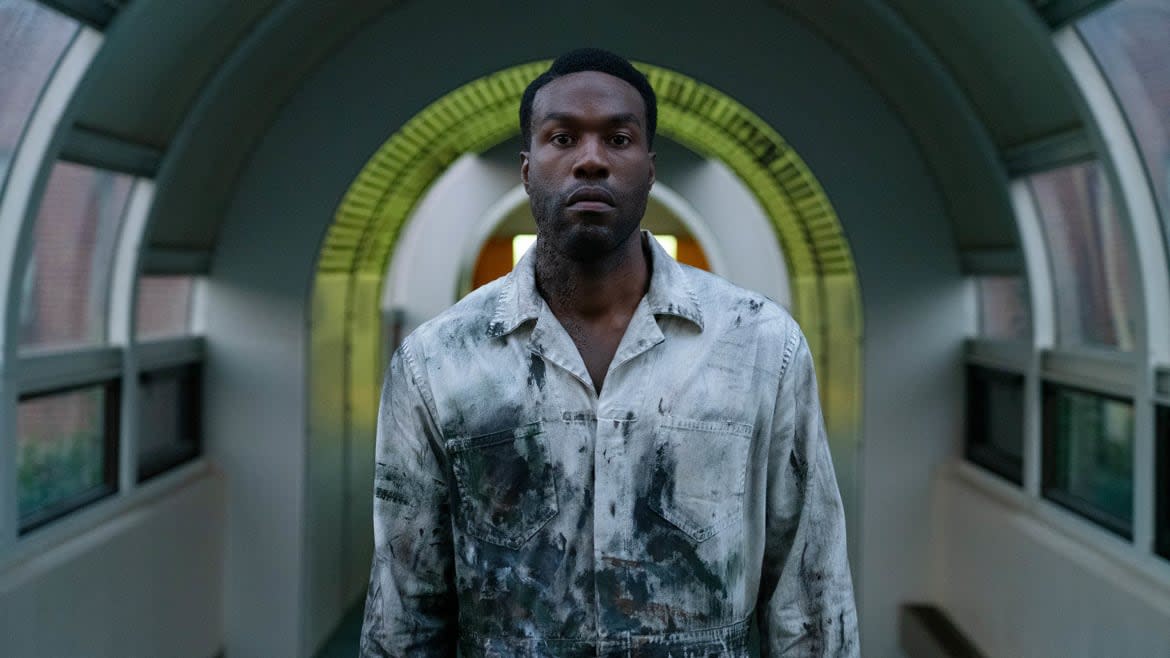‘Candyman’ Is Just Not ‘Candyman’ Without Tony Todd

- Oops!Something went wrong.Please try again later.
- Oops!Something went wrong.Please try again later.
- Oops!Something went wrong.Please try again later.
- Oops!Something went wrong.Please try again later.
It’s a philosophical question for the ages: If you make a Candyman movie without letting Tony Todd purr some terrified white woman’s name, imploring her to “be my victim,” have you really made a Candyman movie? Nia DaCosta, who previously directed Tessa Thompson in the quietly gripping crime thriller Little Woods, decided to find out.
In 1992, Todd’s seductive performance as the hook-handed phantom of lynching victim Daniel Robitaille made him a horror icon. Robitaille doesn’t command much screen time in any of the Candyman films (Todd doesn’t show up in the original until 45 minutes in) but the character never relinquishes his command as the story’s gravitational center. Despite the film’s middling commercial success, Todd’s ravishing rasp and mouthful of bees proved indelible—and earned the franchise two sequels.
But in her film, something between a sequel and a spiritual remake, DaCosta pushes Robitaille out of the limelight. (Todd shows up, but only for a brief cameo.) Instead of a specific person, this film’s Candyman is the embodiment of all lynching victims.
But wasn’t that always the case?
Before he was a specter that unwitting suspects summoned via mirror, Daniel Robitaille was a painter born to enslaved parents in Louisiana whose only crime was falling in love with one of his white clients’ daughters. A mob chased him down, cut off his right hand, and smeared honeycomb over his body, allowing bees to devour him before burning his body to ash—which they spread on the land that would one day become Cabrini-Green.
Candyman has always been more interested in story than character, save for Robitaille—whose narrative binds the three original films together. 1995’s Candyman: Farewell to the Flesh explored Robitaille’s history further through the eyes of Annie Tarrant, a schoolteacher who we eventually discover is his direct descendant. In Candyman 3: Day of the Dead, released in 1999 and set in 2020, we learn that he eventually did kill her—as he begins to demand that her daughter, Caroline, “Believe in me... Be my victim.” (DaCosta’s film ignores the sequels.)
Todd’s performances in this series are reliably captivating and terrifying. With each murmured threat, the actor bores further into the exact meeting point between two mythological demons that haunt the white imagination: the dangerous, aggressive Black man and the hyper-sexualized Black man. Daniel Robitaille is a paradoxical blend of martyr and avenger, prey and predator, saint and demon. His virtues are his own, and his sins are the re-enactments of others’—even if he will always suffer the blame.
In other words, Daniel Robitaille represents intergenerational trauma incarnate. And as inventive as some aspects of DaCosta’s fascinating sequel are, its greatest sins stem from his absence.
As one might predict, however, Yahya Abdul-Mateen II nonetheless plays the hell out of up-and-coming Chicago artist Anthony—who follows in Helen Lyle’s footsteps as he searches for the Candyman and slowly unravels. Once seen as the golden child of Chicago’s art scene, Anthony’s paintings of nooses around Black men’s necks are no longer selling—so he starts poking around Cabrini-Green for inspiration, and finds way more than he bargained for.
WandaVision star Teyonah Parris plays Anthony’s girlfriend Brianna, an art curator whose patience for her boyfriend’s eccentricities begins to wane when those quirks begin threatening her professional success. The couple lives in a luxury high rise over which the shadow of the now demolished Cabrini-Green towers, the setting of the original film, still looms in spirit. And then there’s Colman Domingo’s William, a longtime Cabrini-Green resident whose psyche has clearly been wounded by all of the violence he’s both witnessed and been made complicit in by police.
Previous Candyman movies have all observed white women acting as tourists. Helen Lyle, the anthropology student at the center of Bernard Rose’s original Clive Barker adaptation, wanders through the Cabrini-Green towers snapping photos of graffiti-covered front doors and shit-smeared public bathroom walls. Beyond their explorations of New Orleans and Boyle Heights during the sequels, Daniel’s descendants Annie and Caroline also experience visions of his horrific murder.
Now that Jordan Peele has made Black heroes’ appeal at the box office undeniable for horror studios, the story’s main protagonist is a Black man. Anthony and his girlfriend, the film argues, are tourists in their own right—wealthy interlopers in a space they understand little better than the white clients for whom they launder Black pain into expensive art. (Although some critics, including Vulture critic and Chicago resident Angelica Jade Bastién have pointed out the problems with painting Black and white gentrifiers with the same brush.)
Before Candyman’s release DaCosta explained several of her creative choices, including her decision to avoid brutalizing Black characters on screen in ways that mimic real life. (“It’s about racial violence, it’s about that trauma,” DaCosta told Vanity Fair. “So you can’t shy away from it or pretend it’s not there. But I felt a responsibility to do it with respect and acknowledgment.”)
But the film’s approach also seems to betray a lack of confidence—either in its concept, the conventions of horror itself, or perhaps both.
In eliminating Daniel Robitaille, this new Candyman severed its ties to the one true “character” this franchise has ever had. (Figures like Helen, Anthony, and Brianna tend to participate more like players in a game of Saw.) The film’s straightforward aesthetic also does away with much of the visceral horror that made the original so memorable. Pools of gritty-looking blood, grimy surfaces, and mildew give way to sterile aesthetics not incomparable to the dreaded gentrification cubes that spring up when white yuppies close in on a neighborhood. And in keeping with the ongoing trend of painfully sexless filmmaking, this one throws a bucket of cold water all over the originals’ lustful whispers.

That’s not to say that DaCosta’s visuals are thoughtless. The film’s opening credits, slow-moving shots of iconic buildings like the many-kerneled Marina City towers taken facing straight upward from ground level, foreshadow the inventive cinematography to come. (It’s also a clever reversal of the original film’s credits, which survey the Chicago streets from a bird’s-eye view.) The closing credits are equally impactful—an arrangement of paper cut-outs of eerily brutal killings seemingly inspired by real life, starting with 14-year-old George Stinney, Jr., who had to sit on a phone book when a jury sentenced him to the electric chair after only 10 minutes of deliberation.
Unfortunately, the film’s most creative shots—often involving mirrors—usually establish the dread before a visually forgettable climax. That said, DaCosta’s Candyman does outdo all previous installments in the body horror department toward the end—Cronenberg-like work that seems bound to upset anyone with trypophobia.
Here, symbolism and message take center stage. But clumsy editing choices on the back end of the film make not only its message but its plot somewhat difficult to decipher. Not helping the matter are lines that feel like pre-emptive counterpoints for would-be reviewers of the film on Twitter. When Anthony reveals his new passion project, a medicine cabinet that opens to reveal the horrors Black people have endured for generations, a stuffy art critic at the gallery offers a dismissive comment that could double as a glib critique of the film itself: “Didactic, knee-jerk cliches about the ambient violence of the gentrification cycle.”
But didactic storytelling is not the main issue here; one could argue that all of the Candyman films are a little didactic, or that the franchise as a whole developed a proud tradition of repeatedly explaining its lore about as many times as unsuspecting victims might murmur its villain’s name in a mirror. More troubling is that this purported horror film doesn’t seem to trust the genre’s devices to deliver its message at all, didactic or not.
Get our top stories in your inbox every day. Sign up now!
Daily Beast Membership: Beast Inside goes deeper on the stories that matter to you. Learn more.

